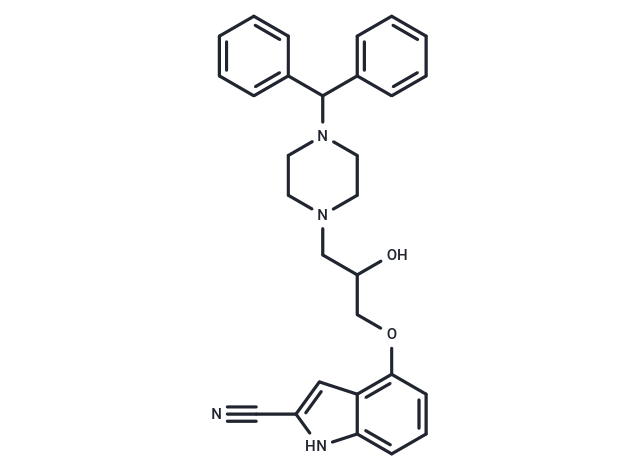Shopping Cart
- Remove All
 Your shopping cart is currently empty
Your shopping cart is currently empty

DPI 201-106 is a cardioselective inhibitor of the TTX-resistant h1 Na channel inactivation resulting in a positive inotropic effect. DPI-201-106 also inhibits the inward and delayed rectifier potassium currents and L-type calcium current.

| Pack Size | Price | Availability | Quantity |
|---|---|---|---|
| 5 mg | 33 € | In Stock | |
| 10 mg | 57 € | In Stock | |
| 25 mg | 116 € | In Stock | |
| 50 mg | 179 € | In Stock | |
| 1 mL x 10 mM (in DMSO) | 34 € | In Stock |
| Description | DPI-201-106 is a cardioselective inhibitor of the TTX-resistant h1 Na channel inactivation. DPI-201-106 inhibits the L-type calcium current, and inward and delayed rectifier potassium currents. |
| In vitro | DPI 201-106(0.1 - 3 μM) produces concentration-dependent positive inotropic effects in guinea-pig and rat left atria, kitten, rabbit and guinea-pig papillary muscles and Langendorff perfused hearts of rabbits[2]. DPI 201-106 increases the Ca2+ sensitivity(EC50 = 0.2 nM) of skinned fibres from porcine trabecula septomarginalis[2]. |
| In vivo | DPI 201-106(0.2 mg/kg i.v) administration increased left ventricular dP/dtmax in anesthetized dogs[3]. |
| Alias | DPI-201-106 |
| Molecular Weight | 466.57 |
| Formula | C29H30N4O2 |
| Cas No. | 97730-95-5 |
| Smiles | OC(COc1cccc2[nH]c(cc12)C#N)CN1CCN(CC1)C(c1ccccc1)c1ccccc1 |
| Relative Density. | 1.31g/cm3 |
| Storage | Powder: -20°C for 3 years | In solvent: -80°C for 1 year | Shipping with blue ice. | |||||||||||||||||||||||||||||||||||
| Solubility Information | DMSO: 250 mg/mL (535.83 mM) | |||||||||||||||||||||||||||||||||||
Solution Preparation Table | ||||||||||||||||||||||||||||||||||||
DMSO
| ||||||||||||||||||||||||||||||||||||

Copyright © 2015-2024 TargetMol Chemicals Inc. All Rights Reserved.